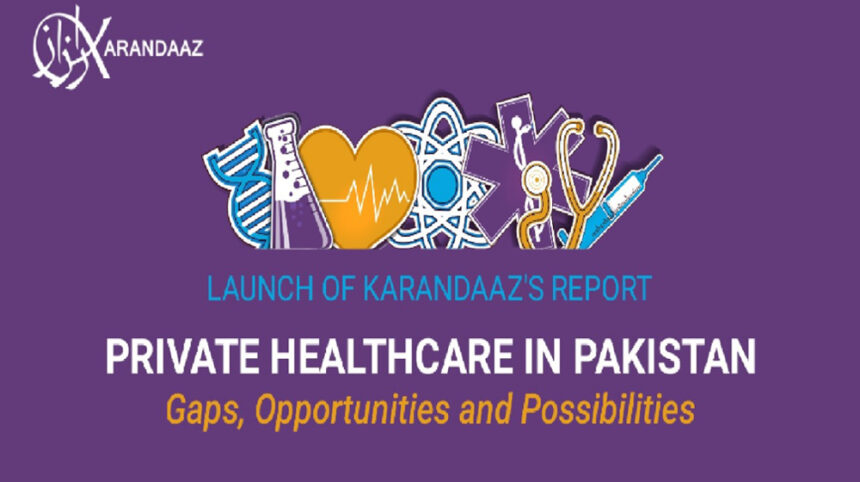The pursuit of enhanced well-being and equitable healthcare is a crucial goal for all nations. Access to high-quality healthcare is not just critical to well-being and human development but also contributes to poverty alleviation, boosts productivity in the workforce, and enhances learning capabilities. Pakistan has made considerable progress in healthcare provision as depicted through the United Nation’s Sustainable Development Goals of health and wellbeing indicators. However, the overall expenditure on health as a percentage of GDP has improved only slightly from 2.14% in 2011 to 3% in 2021. From a regional perspective, Pakistan ranks second to last in South Asia on the Universal Healthcare Coverage (UHC) front.
The healthcare challenge in Pakistan is multifaceted, requiring a multi-pronged approach to make progress against national-level health goals and international commitments. A key issue is low GDP allocation towards healthcare (historically between 0.8 to 1.2%), exacerbated by the mounting pressures due to population growth. The country grapples with a dual-disease burden characterized by both communicable and non-communicable diseases. With approximately 15 million people affected by Hepatitis B and C, the country ranks as the 5th highest tuberculosis burden in the world and the focal geographical area of malaria endemicity. Non-communicable diseases such as diabetes, cardiovascular conditions, and respiratory illnesses account for approximately 60 per cent of deaths, while there is a significant burden of communicable diseases in neonatal conditions.
Tech-enabled solutions for improving healthcare delivery have gained significant prominence and policy focus around the globe. It is no coincidence that developed countries such as Switzerland and Germany, which have the highest UHC, have also performed extremely well in terms of healthcare innovation, of which technology is a major component, along with quality, choice, and fiscal sustainability, according to the World Index of Healthcare Innovation (2022).
This is not to say that Pakistan has not made headway in health tech. Private sector entities have taken several initiatives in various facets of healthcare. Entities like SLOSH AI have used AI to streamline radiological examinations, addressing the shortage of radiologists in the country by improving core diagnostic processes. Sehat Kahani and Dawaai.pk were one of the early entrants in telemedicine and remote consultations, with the former connecting out-of-the-labour force female doctors to patients virtually, while the latter was an online pharmacy before branching out to telemedicine. MedzNMore has designed a just-in-time delivery system for pharma retailers, reducing their burden of working capital.
While the growth of health tech through the private sector is encouraging, there are various complexities with the healthcare system that need to be understood and untangled. First, Pakistan’s largest UHC programme to date which has over 300 private and public hospitals in 84 districts, not only needs to be expanded but needs to be harmonized with the private sector, especially health-tech. Second, the problem of lack of referral systems and data sharing between health facilities needs to be addressed because the patient flow in the country is heavily tilted towards the tertiary sector driving up out-of-pocket costs and expenditure per capita. This also requires a public-private partnership model so that the first line of intervention for a patient is primary care (general physician) followed by second care (specialist) and tertiary care (advanced care in a specialized facility). Investments in technology and policy initiatives are required to establish information-sharing platforms between the private and public sectors.
Owner-operated small clinics and establishments fill the void caused by the public sector’s neglect and underfunding of Basic and Rural Health Units in primary healthcare. These clinics can also act as a conduit through which this public primary healthcare is outsourced with the state playing the role of a regulator and insurance provider. This will have a domino effect as public sector inefficiencies will be reduced, public expenditure will go down and incidence of insurance provision will go up. As a result, patients will experience a reduction in the final cost they bear. In this regard, AI-enabled models can play a critical role in improving the allocative efficiency of existing national health insurance programmes, such as the Sehat Sahulat Programme, through leveraging big-data to improve the accuracy of risk-profiling and risk-based costing for subsidy provision.
The Pakistani healthcare landscape is fractured and characterized by inefficiencies in the public sector leading to a void that is filled by the private sector, especially small family-owned establishments. With public healthcare overburdened and inaccessible, patients rely on private healthcare leading to a serious affordability problem – with out-of-pocket expenses as high as 35% of the average household income. Health-tech entrepreneurs have somewhat disrupted this landscape by impacting core medical processes and service provision solving the affordability problem to some extent. The transformative potential of tech-driven innovation is evident; however, it necessitates investment focus, policy initiative, and robust public and private partnerships.
This article is written by Ali Akbar Ghanghro – Senior Manager of Research and Insights, Karandaaz & Muhammad Saad Sarfraz – Analyst, Research & Insights, Karandaaz.







